Mr. Low could not have imagined that the cavernous malformation in his brainstem, which over the past year had caused him bad sleep and difficulties eating, could be excised just that easily. "I have no discomfort whatsoever. "
His chief physician, Professor Bertalanffy, gave him a thumbs up and told him in Chinese: "You can get out of bed and walk around a little. It's no problem. "
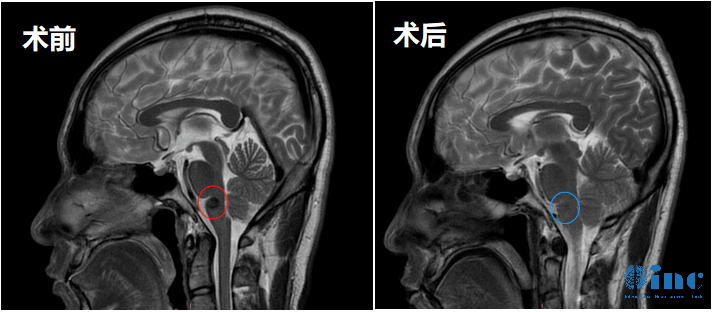
This was only on the second day after his surgery. Professor Bertalanffy's confident tone filled Mr. Low with calm, and a smile that had been absent for a very long time spontaneously reappeared on his face. He realized that now he was cured, liberated from the burdens that the cavernoma in his brainstem had caused him. From here on, we would be healthy and happy.
Before 24 hours had passed since his surgery, Mr. Low was already transferred from the ICU back to the normal ward. Ms. Low, having been waiting anxiously throughout her husband's surgery, felt a weight had been lifted from her chest. As she saw her husband return in such favorable condition, all her fears disappeared and she was overcome with joy.
Diagnosis: Brainstem cavernoma of the midbrain
One year prior, Mr. Low was in his early thirties and at the beginning of his career. Generally, he was of very good health, apart from an occasional numbness that had recently started to cause him minor discomfort. Not suspecting any major issues, Mr. Low instead was devastated to find out he was harboring a cavernous malformation in his brainstem. It was located in the medulla oblongata, the lower part of the brainstem that regulates vital functions such as heartbeat and respiration. A hemorrhage of the cavernoma could have catastrophic consequences, respiratory difficulties, complete paralysis or coma.
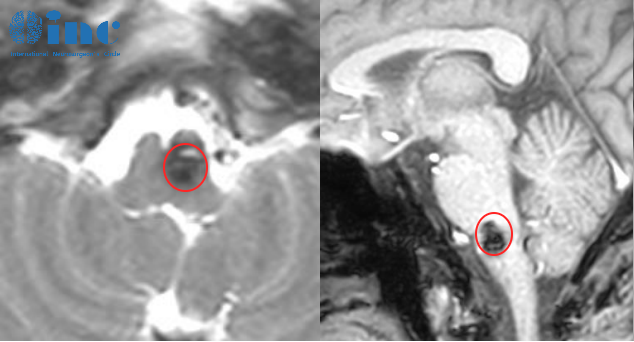
Although at the current stage, Mr. Low's symptoms were very mild, it was impossible to predict when this brainstem cavernoma would hemorrhage and cause more serious problems. Mr Low started to feel distinctly uneasy about this danger, often laying awake late at night. Wherever he sought medical advice, Mr. Low didn't get the result he had hoped for. Surgery in that location-the medulla oblongata-is considered too complex. That is why most doctors recommend observation or Gamma-Knife treatment.
Evaluation: "Surgery is necessary, risks will be close to zero. "
Mr. Low was unwilling to give himself up to his disease at such a young age. He consulted doctors everywhere and asked around in online patient communities. In his search for a treatment, he learned that Professor Bertalanffy would soon come to China to perform surgical demonstrations together with INC's Chinese partners. He was widely considered one of the leading experts on brainstem surgery. In recent years, many patients with brainstem cavernoma considered to be inoperable had received curative surgery by Professor Bertalanffy. Mr. Low decided to consult the professor and ask whether there was a chance to receive treatment.
INC's medical gathered Mr. Low's medical reports from the past few years and had him perform a new MRI scan. After his documentation was translated and sent to Professor Bertalanffy, he received a detailed response to his questions about the possibility of surgery, recurrence rate, whether conservative treatment (observation) or Gamma-Knife therapy were an option.
Consulting with Professor Bertalanffy:
1. Based on the patient's documentation, do you think surgery is possible? Is Gamma-Knife treatment an option? If neither surgery nor Gamma-Knife are done, how high is the risk of another bleeding?
Yes, surgery is possible and even necessary in order to avoid future bleedings and neurological problems from this vascular malformation. Gamma-Knife treatment is the worst option the patient can choose! Gamma-Knife therapy causes certain complications, and it definitely will not prevent future bleeding. He should opt for surgery because this will eliminate the vascular malformation from his brainstem and will prevent future problems.
2. If treated conservatively, what should be payed attention to in normal life and work?
If the patient decides not to undergo surgery he will need regular MRI controls. However, there is little he can do in daily life to prevent future bleeding, so normal life will be adequate.
3. How high is the risk of surgery? What are the complications and risks of surgery?
In my hands, the surgical risk will be close to zero, because I have operated on so many patients with similar cavernoma in exactly this location without permanent postoperative deficits.
4. What is the chance of recurrence after surgery? What is the chance of that happening?
Risk of recurrence may be estimated at less than 3%;I would rather not expect it in this patient after surgery.
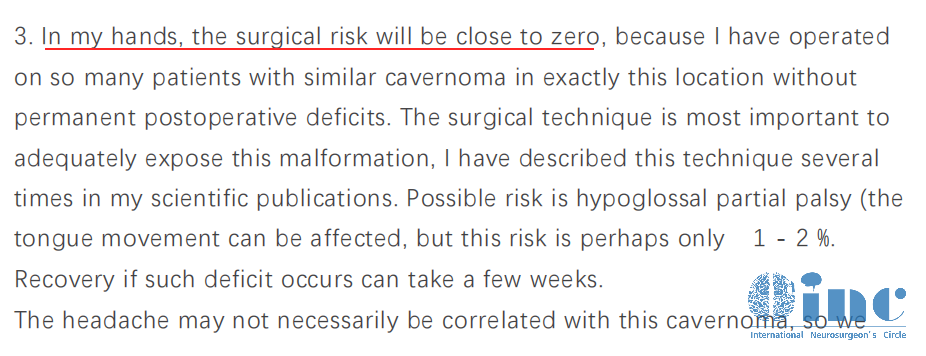
Extract from Professor Bertalanffy's consultation report
Mr. Low was so excited to learn that Professor Bertalanffy could safely resect his brainstem cavernoma that he was the first to secure a slot for the 2022 round of surgical demonstrations.
Diffusing a“ticking time bomb”
Pre-operative talk
One day before the surgery, Mr. Low, his wife and Professor Bertalanffy again discussed in detail all aspects of the surgery.
Ms. Low: "Can you completely remove the cavernoma? "
Professor Bertalanffy: "In general, cavernous malformations should be removed complete, otherwise the surgery would be meaningless. "
Mr. Low: "Will I experience any complications after the surgery?
Professor Bertalanffy: "You will not have any new complication. "
This firm, confident response reassured Mr. and Ms. Low and inspired in them the trust that this surgery would safely and completely remove the cavernoma from Mr. Low's brainstem.
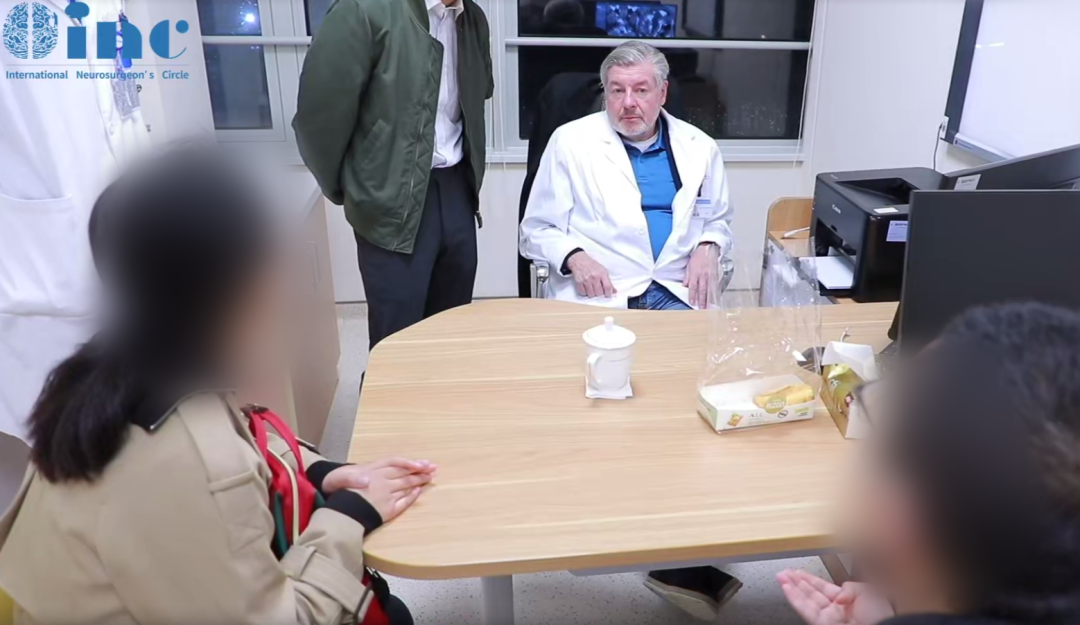
Surgery
The surgery was performed without complications at one of INC's partner hospitals, the Soochow Dushu Lake Hospital. Under continuous neurophysiological monitoring, Professor Bertalanffy removed Mr. Low's brainstem cavernoma.
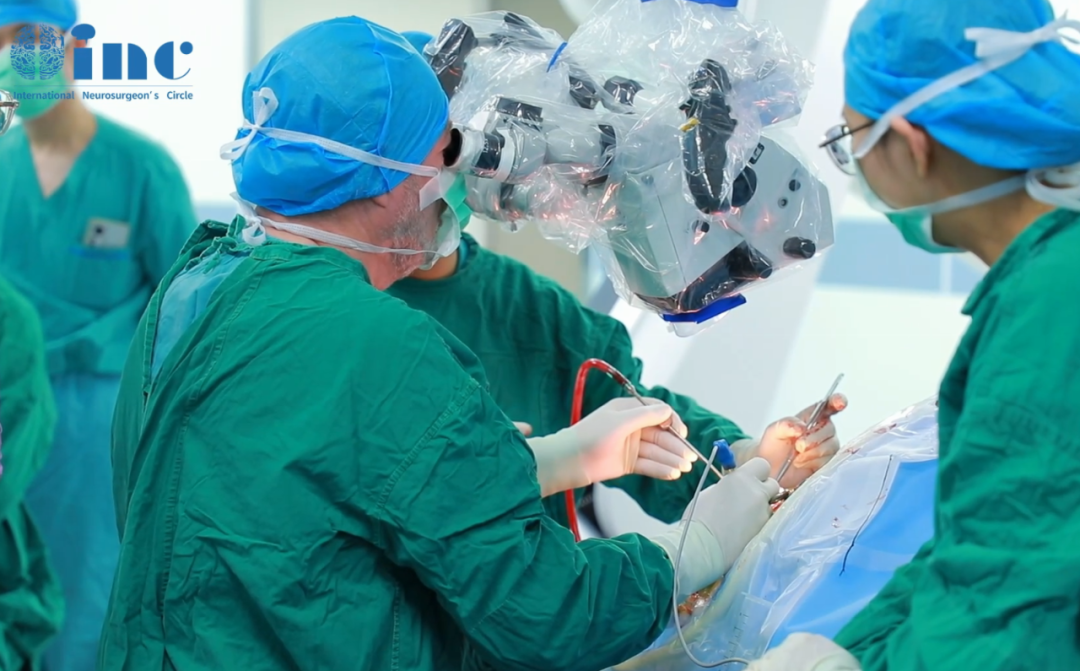
Post-operative recovery
On the first post-operative day, Mr. Low was still resting in the ICU. He was fully conscious and alert, could move his arms and legs, and was able to clearly answer any questions by Professor Bertalanffy. When being asked how he was feeling, he replied that he had some pain in his left ear immediately after waking up from the anesthesia, but that it had already disappeared and that he didn't have any discomfort otherwise.
On the second day, Mr. Low was transferred back to the normal ward, and he was in exceptionally good spirits. He didn't show any signs of new neurological deficits. "I have no discomfort whatsoever, "he said. Professor Bertalanffy was very pleased to hear this and he encouraged Mr. Low to get out of his bed and start walking around slowly. Witnessing his speedy recovery, everyone visiting Mr. Low that day was extremely happy, filling the room with joy and laughter. Mr. Low expressed his heartfelt gratitude to Professor Bertalanffy for successfully performing this surgery.
Three months after his surgery, apart from not being able to exercise excessively, Mr. Low fully returned to a normal life. Professor Bertalanffy, after having evaluated Mr. Low's follow-up MRI and his physical condition, confirmed that everything was okay. The cavernoma was completely removed, leaving only the venous malformation in place, a functional blood vessel that, though malformed, had an important function and shouldn't be removed under any circumstances. Small hemosiderin deposits could also be seen on Mr. Low's follow-up images, which also constitute a normal finding.
Mr. Low's MRI three months after surgery
Our entire team is very happy for Mr. and Ms. Low. Over the past year, their life had been dictated by Mr. Low’s brainstem cavernoma. Now that it was removed, and with Mr. Low showing such remarkable recovery, they can finally leave the disease behind and move on happily together.